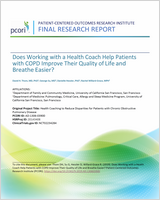|
Primary outcomes
| | | |
| COPD-related QOL | SF-CRQ | Patient survey |
55
|
| Dyspnea | SF-CRQ dyspnea domain | Patient survey |
55
|
|
Secondary outcomes
| | | |
| COPD exacerbations | Review of medical records | Electronic medical records |
63
|
| Exercise capacity | 6-Minute Walk Test | Administered by RA | 83, 84 |
| Self-efficacy for COPD management | Stanford Self-efficacy for Managing Chronic Disease | Patient survey |
73
|
|
Other prespecified outcomes
| | | |
| Quality of care (PACIC) | Patient Assessment of Chronic Illness Care | Patient survey | 74,75 |
| COPD symptoms | COPD Assessment Test | Patient survey |
76-78
|
| Lung function | Forced expiratory volume at 1 second by spirometrya | Administered by RA | NA |
| Smoking status | Smoked cigarette in past 30 d | Patient survey | NA |
| Functional status | Bed days due to respiratory problems | Patient survey | 79, 80 |
| Correct use of inhalers | Inhaler checklist for each type of inhaler (adapted) | Observed by RA | 47, 81, 85 |
| Knowledge of COPD | Individual questions created for study | Patient survey | NA |
| Outpatient visits | Visits to PCP, urgent care, or pulmonary specialist in 12 mo before enrollment or during 9-mo study period | Electronic medical records | NA |
Hospitalizations COPD related For other reason
| Rate per person-year during the 12 mo before enrollment or during 9-mo study period | Electronic medical records | NA |
Emergency department visits COPD related For other reason
| Rate per person-year during the 12 mo before enrollment or during 9-mo study period | Electronic medical records | NA |
|
Post hoc outcomes
| | | |
| Symptoms of depression | Patient Health Questionnaire | Patient survey |
82
|
| Guideline-concordant prescription medications | Prescription medication corresponding to GOLD recommendations by severity category (A, B, C, or D) of COPD | Electronic medical records |
6
|
